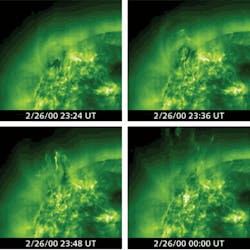Light-activated liquid-crystal membrane allows selective transmission of gases
Researchers at the University of Rochester's Laboratory for Laser Energetics (Rochester, NY) have developed a unique membrane that blocks gas from flowing through it when one color of light is shone on its surface, and permits gas to flow through when another color of light is applied. The membrane consists of a piece of hard plastic riddled with 0.01 mm diameter holes (fabricated via neutron-beam milling) filled with dye-doped liquid crystals through capillary action. When purple light with a wavelength greater than 420 nm illuminates the surface of the membrane, the dye molecules straighten out and the liquid-crystal structures are oriented along the center axis of the cylindrical holes, allowing gas to easily flow through. But when UV light illuminates the surface, the dye molecules bend into a banana shape and the liquid crystals scatter into random orientations, causing a substantial dip in the permeability of the membrane.
The reversible membrane, which follows a simple sorption-permeation model, switches within 5 s for incident intensity values of only 2 mW/cm2. The light-activated membrane can be operated remotely (unlike conventional heat or electricity activated membranes) without causing damage to the membrane, eliminating the potential for gas ignition. Contact Kenneth Marshall at[email protected].
More Laser Focus World Current Issue Articles
More Laser Focus World Archives Issue Articles

